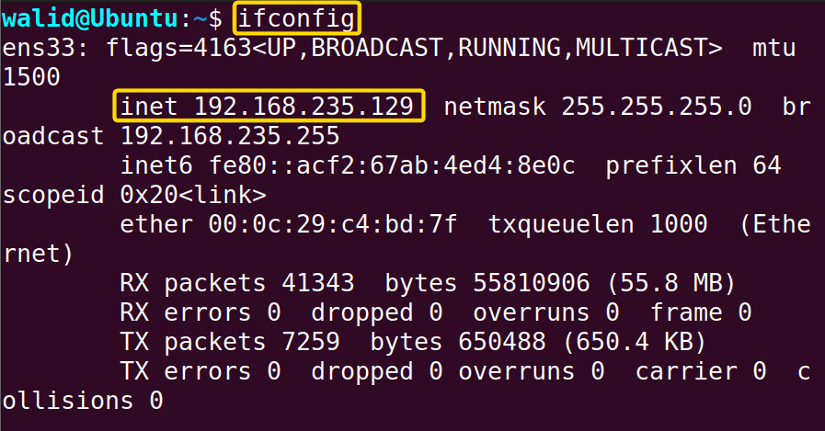The sftp command in Linux is similar to the ftp command. However, it transfers files from one computer to another computer more securely. The data is end-to-end encrypted. So even if someone gets a hold of the data, he won’t be able to access it. The sftp command in Linux uses the SSH (Secure Shell) protocol. In this article, I will show some primary usage of the sftp command with some necessary concepts.
A. Description
The sftp command in Linux is a part of the SSH protocol suite, which was first developed in the 1990s. In a very short time. It took over the ftp command as it is not a secure way to transfer data. Over time, the sftp command has become more advanced. It is also easy to use. Someone with basic networking knowledge can set up a server and transfer files.
B. Syntax
The syntax of the sftp command in Linux goes like the following:
sftp [OPTION]... username@ip_addressC. Options
The sftp command in Linux provides many options to satisfy your needs. You can check them by yourself by the following command:
man sftpI have listed some of the useful options for in down below:
Useful Options
- -C, compresses.
- -l, limits bandwidth.
- -P, specifies a port.
- -p, preserves original files attributes.
- -r, is used to copy directories.
- -4, uses IPv4.
- -6, uses IPv6.
How to Setup an SFTP server
Previously, I have mentioned that the sftp command in Linux transfers files between two computers- a client and a server. In this article, I will use Ubuntu installed in WSL (Windows Subsystem for Linux) as the client computer. I also used Windows Terminal to customize the output. Secondly, I installed Ubuntu on VMware Workstation Pro and I will use it as the SFTP server. Now follow the steps below to set up a server:
❶ Open an Ubuntu Terminal on the server computer.
❷ (Optional) Copy the following command to update your system and hit ENTER:
sudo apt-get updateYour output will be like the one below. The command will update your local package index, which determines what package is available and manages dependencies.
sudo apt-get install openssh-serverThe installation will be completed in a minute.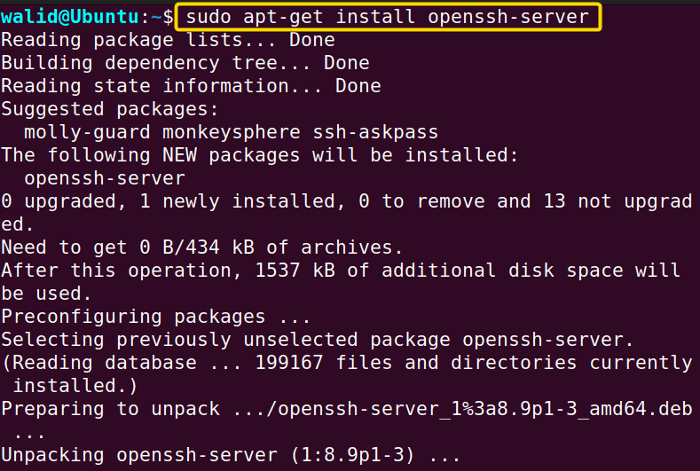
sudo service ssh startsudo service ssh statusIf you see “active (running)” message in blue, your server is ready.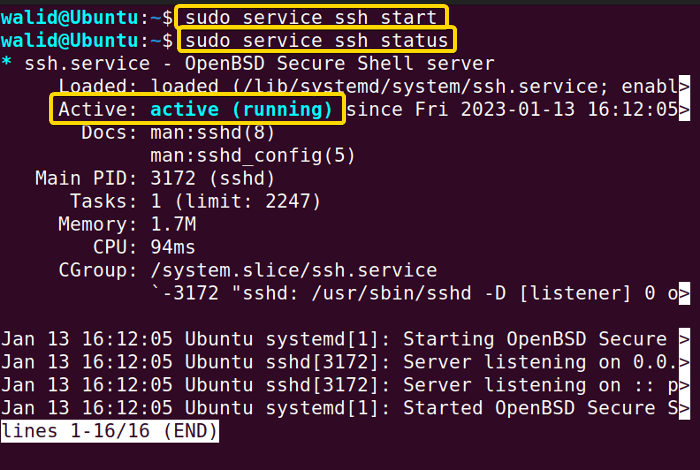
ifconfigsudo apt-get install net-toolsThe IP address of my server is 192.168.235.129, and I will use it in this article. Don’t worry if you get a different IP address.
Practical Examples of the “sftp” Command in Linux
In this section, I will show you how to use the sftp command in Linux. Try to understand every concept and follow every step carefully. For your information, I have used both the client and server in these examples. Remember, the client goes like “walid@client” and the server goes like “walid@Ubuntu”.
Example 1: Connect to an SFTP Server Using the “sftp” command in Linux
At first, I will connect to the SFTP server using the sftp command in Linux. To connect to an SFTP server, you need your username, password and the IP address of the server as well. In my case, my username is walid and my IP address is 192.168.235.129. Now do the following to connect to an SFTP server:
Steps to Follow >
➊ At first, open an Ubuntu Terminal in your client computer.
➋ Copy the following command in the Terminal and press ENTER:
sftp [email protected]➌ Provide the password associated with your username and Hit ENTER again.
Output >
In the output, it is showing “Connected to 192.168.235.129” and “walid@client” is replaced by “sftp>” which denotes that it is ready to take any sftp commands and execute it.
Similar Readings
- The “wget” Command in Linux [14 Practical Examples]
- The “ping” Command in Linux [9 Practical Examples]
- The “curl” Command in Linux [9 Practical Examples]
- The “ dig” Command in Linux [10 Practical Examples]
Example 2: Upload a File Using the “sftp” Command in Linux
Let’s upload a file to the server using the sftp command in Linux. I will the “get” command for that. Firstly, I used the following command to view files in the client computer:
lsYou can see a file by the name of local_file in the home directory of my client computer. Now I will upload it to the server.
Steps to Follow >
➊ Firstly, launch an Ubuntu Terminal in the client computer.
➋ Write the following command to connect to the server and hit ENTER:
sftp [email protected]➌ Give your password and press ENTER again.
❹ Copy the command below to upload a file:
put local_file❺ Finally, find the ENTER key in your keyboard and hit it.
Output >
You will see “Uploading” followed by the name of the file in your terminal. You will also see the directory where the file will be uploaded. Moreover, the output of the sftp command contains the following five things respectively – filename, percentage, bytes Transferred, speed and estimated time.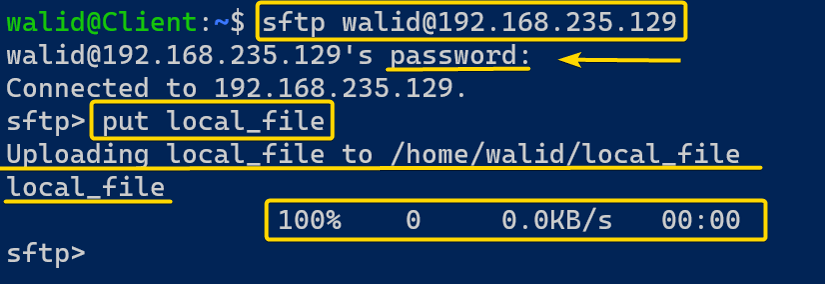
lsSee, there is file named local_file in the server. I have successfully uploaded the file to the server.
Example 3: Download a File from the SFTP server
Now I will download a file from the server using the sftp command in Linux. I need to use the get command for this purpose. At first, I executed the following command to view the available files in my server:
lsThere is a file by the name of remote_file in the home directory of the server. Now download it to the home directory of the client computer.
Steps to Follow >
➊ Go to your client computer and open an Ubuntu Terminal.
➋ Insert the following command in the Terminal to connect to the server and hit ENTER:
sftp [email protected]➌ Provide the password and press the ENTER button again.
❹ Now type the command below to download a file from the server:
get remote_file❺ Press the ENTER button from your keyboard.
❻ Copy the command below to quit the session and hit ENTER:
exitOutput >
In the output, if you see “Fetching”, your file is downloading. You will also see the path of the remote_file in server. Moreover, I executed the following command in the terminal to check whether the file was downloaded or not:
lsAs you can see, there is a file named remote_file. So I have successfully downloaded the file using the sftp command in Linux.
Example 4: Copy a Directory Using the “sftp” Command in Linux
In the last two examples, you have seen how to copy files. What if you want to copy a whole directory? You can do that as well using the sftp command in Linux. In this example, I will show you how to copy a directory from the server to the client computer. Firstly, I executed the following command in the server to see my directory:
lsThere is a directory by the name of mydirectory in my server. Now let’s copy it to the client computer.
Steps to Follow >
➊ At the beginning, open an Ubuntu Terminal on your client computer.
➋ Write the following command to connect to the server and Hit ENTER:
sftp [email protected]➌ Provide the password associated with the username and press ENTER again.
❹ Type the following command to copy a directory from the server:
get -r mydirectory❺ Find the ENTER button on the keyboard and press it.
❻ Copy the command below to quit the session and hit ENTER:
exitOutput >
In the output, you will see “Fetching” and “Retrieving” which denote that the sftp command in Linux is copying the mydirectory to the client computer. Then I used the following command in the client computer to list out all the directories:
lsSure enough, there is a directory named mydirectory in the client computer.
Similar Readings
- The “nslookup” Command in Linux [12 Practical Examples]
- The “ufw” Command in Linux [12+ Practical Examples]
- The “ssh” Command in Linux [18 Practical Examples]
- The “traceroute” Command in Linux [13 Practical Examples]
Example 5: Make and Change into a Directory
Unlike the scp command, you can run commands in the SFTP command prompt of the sftp command in Linux. Now, I will make a directory in the home directory of the server and change into that directory by running commands in the SFTP command prompt. To make a directory and go into that directory, do the following:
Steps to Follow >
➊ Launch an Ubuntu Terminal in the client computer firstly.
➋ Insert the command below to connect to the SFTP server and hit ENTER:
sftp [email protected]➌ Give your password and press the ENTER button.
❹ Now, write the following command and press ENTER to make a directory:
mkdir mydirectory❺ To go into the previously created directory, copy the command below:
cd mydirectory❻ Hit the ENTER key on your keyboard.
Output >
Sadly, you won’t see any notifications about whether your directory has been created. I will show you how to list out all the contents from the SFTP command prompt in the next example. Then I went into the newly created mydirectory and executed the following command to the current directory:
pwdAs you can see, the path is “/home/walid/mydirectory” which denotes that the directory has been successfully created in the home directory of the server computer.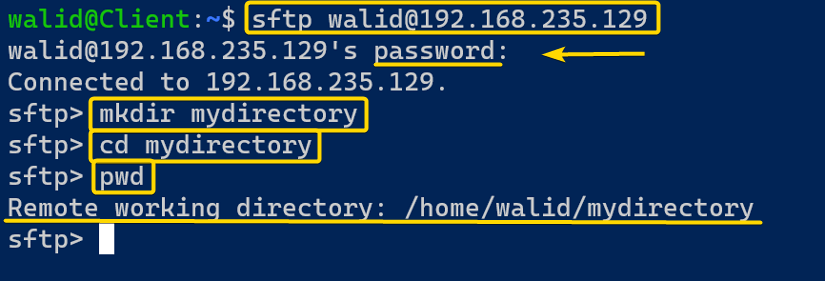
lsAs expected, there is a mydirectory in the server.
Example 6: List the Contents of a Directory Using the “sftp” Command in Linux
Finally, I will list the contents of a directory from the command prompt of the sftp command in Linux. In the beginning, I executed the following command in the server computer:
lsAs you can see, there are three files (myfile1, myfile2, myfile3) in the home directory of the server. So, I would expect to see the same output.
Steps to Follow >
➊ Open an Ubuntu Terminal in the client computer first.
➋ Copy the following command to connect to the SFTP server and hit ENTER:
sftp [email protected]➌ Provide your password and press ENTER.
❹ Write the following command to view all the files of a directory:
ls mydirectoryOR,
dir mydirectory❺ Press the ENTER button once again.
Output >
Here I executed both the “ls” and “dir” commands and both of them serve the same purpose. And in both cases, I got the same output showing the myfile1, myfile2, and myfile3 files.
Conclusion
If you are interested in networking, then the sftp command in Linux is tool to wrap your head around. It is a convenient tool to transfer files between two computers securely. I hope the examples in this article have helped you to build a strong foundation in the sftp command in Linux.
Similar Readings
- The “rsync” Command in Linux [10 Practical Examples]
- The “screen” Command in Linux [13 Practical Examples]
- The “arp” Command in Linux [7 Practical Examples]
- The “ftp” Command in Linux [14 Practical Examples]
- The “host” Command in Linux [10 Practical Examples]
- The “scp” Command in Linux [4 Practical Examples]
FUNDAMENTALS A Complete Guide for Beginners

